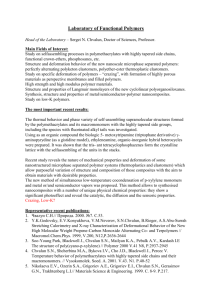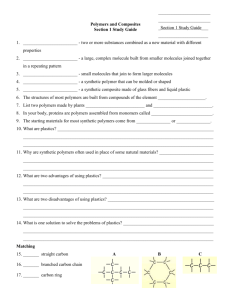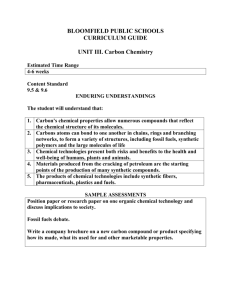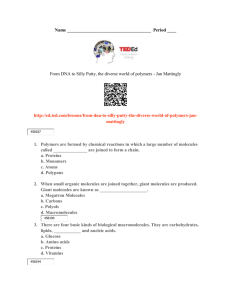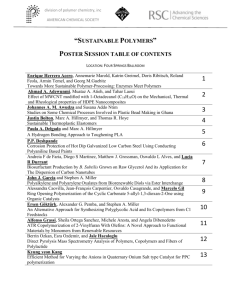Chapter 15. Applications, and Processing of Polymers
advertisement
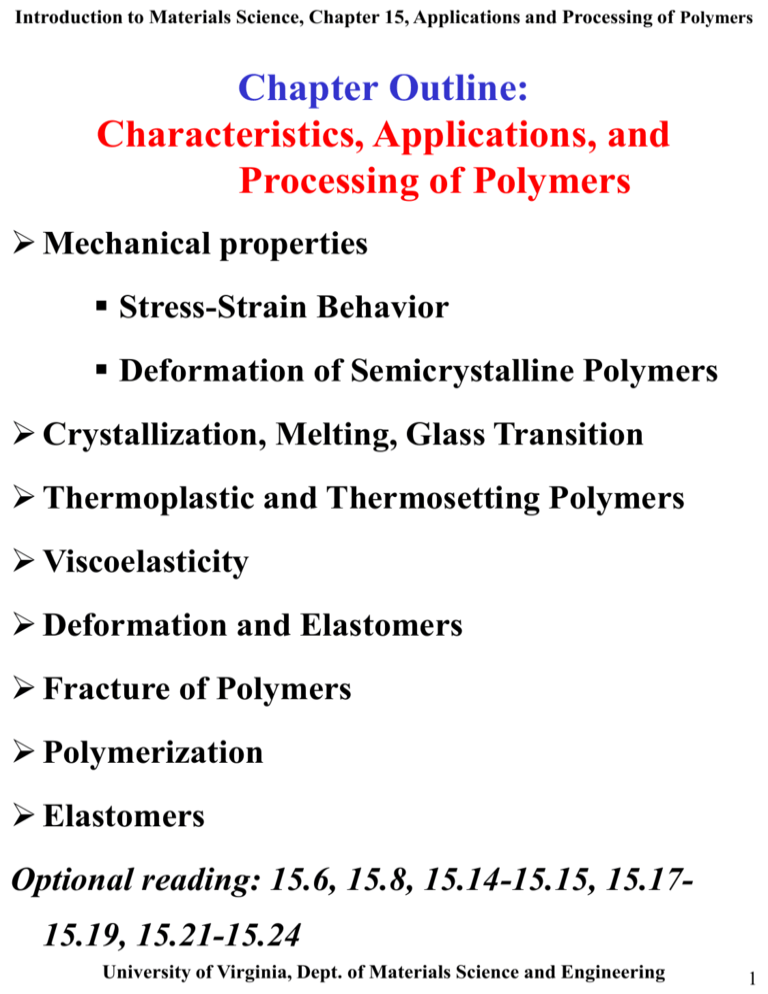
Introduction to Materials Science, Chapter 15, Applications and Processing of Polymers Chapter Outline: Characteristics, Applications, and Processing of Polymers Mechanical properties Stress-Strain Behavior Deformation of Semicrystalline Polymers Crystallization, Melting, Glass Transition Thermoplastic and Thermosetting Polymers Viscoelasticity Deformation and Elastomers Fracture of Polymers Polymerization Elastomers Optional reading: 15.6, 15.8, 15.14-15.15, 15.1715.19, 15.21-15.24 University of Virginia, Dept. of Materials Science and Engineering 1 Introduction to Materials Science, Chapter 15, Applications and Processing of Polymers Stress – Strain Behavior (I) A: Brittle Polymer B: Plastic Polymer C: Elastomer Stress-strain behavior can be brittle (A), plastic (B), and highly elastic (C) Curve C is totally elastic (rubber-like elasticity). This class of polymers - elastomers University of Virginia, Dept. of Materials Science and Engineering 2 Introduction to Materials Science, Chapter 15, Applications and Processing of Polymers Stress – Strain Behavior (II) Elastic Modulus – defined as for metals Ductility (%EL) – defined as for metals Yield strength – For plastic polymers (B) maximum on curve just after the elastic region (different from metals) Tensile strength is defined at the fracture point and can be lower than the yield strength (different from metals) University of Virginia, Dept. of Materials Science and Engineering 3 Introduction to Materials Science, Chapter 15, Applications and Processing of Polymers Stress – Strain Behavior (III) • Moduli of elasticity • Polymers: ~ 10 MPa - 4 GPa • Metals: ~ 50 - 400 GPa • Tensile strengths • Polymers: ~ 10 - 100 MPa • Metals: 100’s - 1000’s MPa • Elongation • Polymers: up to 1000 % in some cases • Metals: < 100% University of Virginia, Dept. of Materials Science and Engineering 4 Introduction to Materials Science, Chapter 15, Applications and Processing of Polymers Mechanical properties of polymers change dramatically with temperature, going from glass-like brittle behavior at low temperatures to a rubber-like behavior at high temperatures. Polymers are also very sensitive to the rate of deformation (strain rate). Decreasing rate of deformation has the same effect as increasing T. University of Virginia, Dept. of Materials Science and Engineering 5 Introduction to Materials Science, Chapter 15, Applications and Processing of Polymers Stress – Strain Behavior (IV) Temperature increase leads to: Decrease in elastic modulus Reduction in tensile strength Increase in ductility polymethyl methacrylate (PMMA) University of Virginia, Dept. of Materials Science and Engineering 6 Introduction to Materials Science, Chapter 15, Applications and Processing of Polymers Deformation of Semicrystalline Polymers Semi-crystalline polymers: crystalline regions separated by amorphous material Elastic deformation: Elongation (straightening) of chain molecules in direction of applied stress. Elastic modulus: determined by elastic properties of amorphous and crystalline regions and the microstructure. University of Virginia, Dept. of Materials Science and Engineering 7 Introduction to Materials Science, Chapter 15, Applications and Processing of Polymers Plastic Deformation of Semicrystalline Polymers Plastic deformation: defined by interaction between crystalline and amorphous regions and is partially reversible. Stages of plastic deformation: 1. elongation of amorphous tie chains 2. tilting of lamellar crystallites towards the tensile axis 3. separation of crystalline block segments 4. stretching of crystallites and amorphous regions along tensile axis Initial structure 1 2 3 4 University of Virginia, Dept. of Materials Science and Engineering 8 Introduction to Materials Science, Chapter 15, Applications and Processing of Polymers Plastic Deformation of Semicrystalline Polymers Necking. Neck gets stronger since deformation aligns the chains and increases local strength in the neck region (up to 2-5 times) neck expands Chains in neck align along elongation direction: strengthening Elongation by extension of neck Different from ductile metals where the deformation is confined in the initial neck region. University of Virginia, Dept. of Materials Science and Engineering 9 Introduction to Materials Science, Chapter 15, Applications and Processing of Polymers Factors that Influence Mechanical properties (I) Temperature and strain rate Chain entanglement, strong intermolecular bonding (van der Waals, cross-links) increase strength Drawing, analog of work hardening in metals, corresponds to neck extension. Is used in production of fibers and films. Molecular chains become highly oriented properties of drawn material are anisotropic (perpendicular to the chain alignment direction strength is reduced) Heat treatment: changes crystal size and order • undrawn material: Increasing annealing temperature leads to increase in elastic modulus increase in yield/tensile strength decrease in ductility. (changes are opposite to metals) • drawn material: opposite changes (due to recrystallization and loss of chain orientation) University of Virginia, Dept. of Materials Science and Engineering 10 Introduction to Materials Science, Chapter 15, Applications and Processing of Polymers Factors that Influence Mechanical properties (II) Tensile strength increases with molecular weight – effect of entanglement Higher degree of crystallinity – stronger secondary bonding - stronger and more brittle University of Virginia, Dept. of Materials Science and Engineering 11 Introduction to Materials Science, Chapter 15, Applications and Processing of Polymers Crystallization, Melting, Glass Transition (I) Crystallization: nuclei form and grow, chains align and order. Rates can be defined from the same type of S-curves we saw in the case of metals. Nucleation becomes slower at higher temperatures. Glass transition: polymers become rigid solids (viscosity increasing) upon cooling yet retain disordered molecular structure like a liquid University of Virginia, Dept. of Materials Science and Engineering 12 Introduction to Materials Science, Chapter 15, Applications and Processing of Polymers Crystallization, Melting, Glass Transition (II) Melting of semicrystalline polymers is intermediate between that of crystalline materials (sharp density change at a melting temperature) and pure amorphous material (melting can be only defined from viscosity). The glass transition temperature is between 0.5 and 0.8 of the melting temperature. University of Virginia, Dept. of Materials Science and Engineering 13 Introduction to Materials Science, Chapter 15, Applications and Processing of Polymers Crystallization, Melting, Glass Transition Melting temperature increases with rate of heating, thickness of lamellae: depends on material history and crystallization temperature. Melting: breaking of the inter-chain bonds: glass and melting temperatures depend on: chain stiffness (e.g., single vs. double bonds) rigid chains -> higher melting temperatures size/weight of molecule - increasing molecular weight increases Tm size, shape of side groups, side branches, crosslinking, defects, etc. Essentially the same molecular characteristics raise and lower both melting and glass transition temperatures. University of Virginia, Dept. of Materials Science and Engineering 14 Introduction to Materials Science, Chapter 15, Applications and Processing of Polymers Crystallization, Melting, Glass Transition Dependence of melting and glass transition temperatures and polymer properties on molecular weight University of Virginia, Dept. of Materials Science and Engineering 15 Introduction to Materials Science, Chapter 15, Applications and Processing of Polymers Thermoplastic and Thermosetting Polymers Thermoplastic polymers (thermoplasts): soften reversibly when heated (harden when cooled) At elevated T inter-chain bonding is weakened allowing deformation at low stresses. Most thermoplasts are linear polymers and some branched structures Thermosetting polymers (thermosets): harden permanently when heated. Covalent crosslinks (~ 10 - 50% of mers) formed during heating. Cross-linking hinder bending and rotations. Thermosets are harder, more dimensionally stable, and more brittle than thermoplasts. Examples: vulcanized rubber, epoxies, resins. University of Virginia, Dept. of Materials Science and Engineering 16 Introduction to Materials Science, Chapter 15, Applications and Processing of Polymers Viscoelasticity (I) Amorphous polymer: glass at low temperatures, rubber at intermediate temperatures, viscous liquid at high T. Low temperatures: elastic deformation at small strains ( = E). Deformation is instantaneous when load is applied. Deformation is reversible. High temperatures: viscous. Deformation is time dependent and not reversible. Intermediate temperatures: viscoelastic behavior. Instantaneous elastic strain followed by viscous time dependent strain. Viscoelastic behavior determined by rate of strain (elastic for rapidly applied stress, viscous for slowly applied stress) Rate dependence of viscoelastic properties in a silicone University Virginia, Dept. of Materials Science and Engineering polymer (SillyofPutty). Picture by Geon Corp. 17 Introduction to Materials Science, Chapter 15, Applications and Processing of Polymers Viscoelasticity (II) Elastic Viscoelastic Viscous Load is applied at ta and released at tr University of Virginia, Dept. of Materials Science and Engineering 18 Introduction to Materials Science, Chapter 15, Applications and Processing of Polymers Viscoelasticity (III) Viscoelasticity characterized by viscoelastic relaxation modulus • Sample is strained rapidly to pre-determined strain • Stress required to maintain this strain over time is measured at constant T • Stress decreases with time due to molecular relaxation processes • Relaxation modulus defined as Er(t) = (t)/e0 • Er(t) also a function of temperature University of Virginia, Dept. of Materials Science and Engineering Log time,t19 Introduction to Materials Science, Chapter 15, Applications and Processing of Polymers Viscoelasticity (IV) Influence of temperature: relaxation modulus plotted at a fixed time for different T: Glassy (elastic) region. Chains are “frozen” Leathery/glass transition region Deformation is time dependent and not fully recoverable Rubbery plateau Rubbery flow (increasing chain motion) Viscous flow (motion of chains largely independent) University of Virginia, Dept. of Materials Science and Engineering 20 Introduction to Materials Science, Chapter 15, Applications and Processing of Polymers Viscoelasticity (V) Temperature dependence for polymer structures A : Largely crystalline isotactic polystyrene. Glass transition region limited – small amount of amorphous material B: Lightly cross-linked atactic polystyrene leathery region extends to decomposition temperature: no melting C: Amorphous polystyrene University of Virginia, Dept. of Materials Science and Engineering 21 Introduction to Materials Science, Chapter 15, Applications and Processing of Polymers Viscoelastic Creep Many polymers susceptible to time-dependent deformation under constant load Viscoelsatic Creep: may be significant even at room temperature and under moderately low stresses (below yield strength) Results of creep tests are described by time dependent creep modulus: Ec(t) = o / (t) Amount of creep decreases as crystallinity increases University of Virginia, Dept. of Materials Science and Engineering 22 Introduction to Materials Science, Chapter 15, Applications and Processing of Polymers Elastomers Can be deformed to very large strains and then spring back elastically to the original length: first observed in natural rubber. Elastomeric polymer: Elastomers are amorphous Unstressed elastomers have coiled/twisted structure – uncoil during deformation Some cross-linking (vulcanization) increases resistance to plastic deformation T above the glass transition temperature below Tg elastomer becomes brittle University of Virginia, Dept. of Materials Science and Engineering 23 Introduction to Materials Science, Chapter 15, Applications and Processing of Polymers Elastomers: Vulcanization (I) Cross linking: required for elastomeric behavior. Vulcanization: irreversible chemical reaction at high T involving addition of sulphur compounds. Sulfur atoms bond with double-bonded C in chain backbones, form the bridge cross-links. Unvulcanized rubber softens at high T and hardens at low T. In 1839 Charles Goodyear found vulcanization by accidentally heating sulphur-coated rubber. He observed it became firm and was stable under heating and cooling. University of Virginia, Dept. of Materials Science and Engineering 24 Introduction to Materials Science, Chapter 15, Applications and Processing of Polymers Elastomers: Vulcanization (II) Cross-linking elastomers are thermosetting polymers Elastic modulus, tensile strength, oxidation resistance increased by vulcanization. E proportional to number of cross-links. Too many cross-links reduces extensibility University of Virginia, Dept. of Materials Science and Engineering 25 Introduction to Materials Science, Chapter 15, Applications and Processing of Polymers Fracture of Polymers Fracture strengths are low compared to metals and ceramics Brittle fracture occurs in thermosetting polymers. Fracture initiated at stress concentrators (scratches, notches, etc). Covalent bonds are severed during fracture In thermoplastic polymers, both ductile and brittle fracture are possible. Brittle fracture occurs at lower T, higher strain rates, and at stress concentrators Brittle to ductile transition often occurs with increasing temperature University of Virginia, Dept. of Materials Science and Engineering 26 Introduction to Materials Science, Chapter 15, Applications and Processing of Polymers Fracture of Polymers: Crazing Fracture of glassy thermoplasts often proceeds through crazing. Crazing occurs when localized regions yield, forming an interconnected array of microvoids. Fibrillar bridges of oriented molecular chains form between voids. At high enough tensile loads, these bridges elongate and break, enabling crack propagation Crazing absorbs fracture energy and increases fracture toughness University of Virginia, Dept. of Materials Science and Engineering 27 Introduction to Materials Science, Chapter 15, Applications and Processing of Polymers Polymerization Polymerization is the synthesis of high polymers from raw materials like oil or coal. It may occur by: 1. Addition (chain-reaction) polymerization, where monomer units are attached one at a time (discussed in Chapter 14). Has three distinct stages: initiation, propagation, and termination. 2. Condensation (step reaction) polymerization, by stepwise intermolecular chemical reactions that produce the mer units. Usually there is small by-product that is then eliminated Significantly slower than addition polymerization Often form trifunctional molecules that can form cross-linked and network polymers University of Virginia, Dept. of Materials Science and Engineering 28 Introduction to Materials Science, Chapter 15, Applications and Processing of Polymers Summary Make sure you understand language and concepts: Addition polymerization Condensation polymerization Elastomer Glass transition temperature Relaxation modulus Thermoplastic polymer Thermosetting polymer Viscoelasticity Vulcanization University of Virginia, Dept. of Materials Science and Engineering 29

